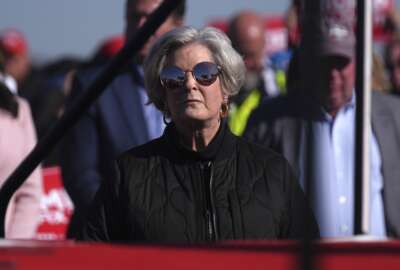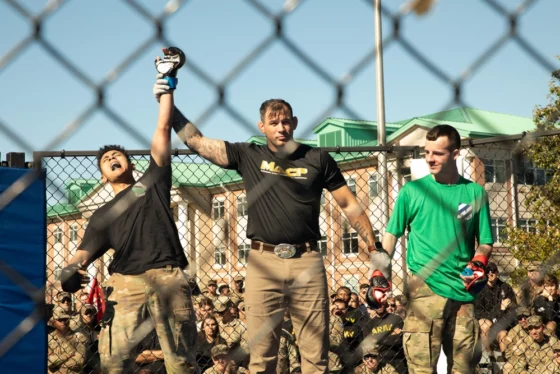
“Volatile, uncertain, complex and ambiguous” – How agencies handle CBRNE threats
There’s an acronym used by federal leaders in the business of preventing or responding to Chemical, Biological, Radiological, Nuclear and Explosive attacks: V...
“The nature of the threat is an abiding one,” said Maj. Gen. Richard Galant, commander of Joint Task Force Civil Support at U.S. Northern Command. “When the nuclear age started we had enough for two bombs. Now, with the civil nuclear fuel cycle, you have hundreds of metric tons around the world.”
That’s why he says it’s so important for various tiers of government, from federal down to local, to be coordinated and aligned when responding to such an attack. And government agencies also need to keep aware of private sector innovations in order to leverage the latest technologies.
And while Galant is working to ensure everything is in place in case of an attack, Jay Tilden, associate administrator and deputy undersecretary for counter-terrorism and counter-proliferation at the National Nuclear Security Administration, is working just as hard to prevent one from happening in the first place.
“We try to play that far game to try to prevent,” he said. “We want to prevent nuclear material going loose, we want to prevent other people’s devices from getting out of control, and we want to prevent terrorist going after nuclear materials.”
They agree that threat streams are increasing, and have been for some time. The Homeland Security Advanced Research Projects Agency added a chemical and biological defense division after the 2001 anthrax attacks. Jon Fischer, its director, says the division is constantly working to adapt defense technology to civilian use, because the military technology doesn’t always work in the civilian world.
For example, he said, a chemical detector could be set off by cleaning solvents.
“So there might be an enclosure where a janitor passes by with an open bottle of cleaning solvent, and it will set the detector off,” Fischer said. “And then you’re clearing out a metro station.”
Another key focus of Fischer’s is the time it takes between a detector sensing illicit materials to agency response.
“The point that a technology detects nuclear material, detects the release of something, if it’s a malevolent act, you’ve already missed it, and you’re already playing the catch-up game,” he said.
Meanwhile, CJ Johnson, assistant director of product acquisition and deployment directorate at the Domestic Nuclear Detection Office has another reason to want faster detection capabilities: trade. Much of his agency’s preventive detection takes place at ports of entry and land border crossing, and lengthy inspections can inhibit legal trade.
“So we want to try to keep the nation safe, but we don’t want to slow down licit streams of commerce,” he said. “So we want to be accurate … but at the same time you want to be fast. You want to be rapid and accurate in detecting something of concern.”
Moderator

Tom Temin, Federal News Radio
Tom Temin has been the host of the Federal Drive since 2006. Tom has been reporting on and providing insight to technology markets for more than 30 years. Prior to joining Federal News Radio, Tom was a long-serving editor-in-chief of Government Computer News and Washington Technology magazines. Tom also contributes a regular column on government information technology.
Panelists
 CJ Johnson, Assistant Director, Product Acquisition & Deployment Directorate, Domestic Nuclear Detection Office
CJ Johnson, Assistant Director, Product Acquisition & Deployment Directorate, Domestic Nuclear Detection Office
Mr. Clarence Johnson, a member of the Senior Executive Service, became the Assistant Director of the Domestic Nuclear Detection Office’s Product Acquisition and Deployment Directorate in June 2015. In this role, he is accountable to the Director for providing oversight of the acquisition and deployment of the nation’s domestic radiological and nuclear detection systems. His portfolio responsibilities include the acquisition, support and deployment of domestic nuclear detection systems, including research and development, program execution, interagency coordination, and integrated lifecycle management of fielded systems. He serves as the DNDO Program Execution Leader for Radiological and Nuclear Detection Equipment, overseeing a portfolio large scale radiological detection equipment and human portable radiological detection systems servicing U.S. sea ports of entry, land ports of entry, land border checkpoints and rail transport capabilities. In addition to leading development and procurement activities for these capabilities, he also facilitates the transition of advanced technologies from laboratories to fielded systems to ensure next generation detection equipment addresses the nation’s most high consequence threats. Through program planning, management and execution, he works to support the field operations of the DHS components and federal/interagency partners in the execution of the radiological and nuclear detection mission, to include: the Customs and Border Protection, the U.S. Coast Guard, the Transportation Security Administration and the U.S. Secret Service. In his current position, he also facilitates close cooperation and support between DHS, DOE, DOD, the Department of State, FBI, state, local, tribal and territorial governments, and the private sector in the procurement and sustainment of radiological and nuclear detection equipment.
 Dr. John Fischer, Director, Chemical and Biological Defense Division, Homeland Security Advanced Research Projects Agency
Dr. John Fischer, Director, Chemical and Biological Defense Division, Homeland Security Advanced Research Projects Agency
In March 2015, Dr. Fischer assumed the position of Director, Chemical-Biological Defense Division within the Science & Technology Directorate of the Department of Homeland Security. The Division’s mission is to strengthen the nation’s security and resiliency by providing knowledge products and innovative technology solutions to enhance National preparedness against both current and future chemical and biological threats. This is accomplished through research and development programs in threat characterization, advanced agent/disease surveillance, agent detection, event attribution and post-event response and restoration support.
 Jay Tilden, Associate Administrator & Deputy Under Secretary for Counterterrorism & Counterproliferation, National Nuclear Security Administration
Jay Tilden, Associate Administrator & Deputy Under Secretary for Counterterrorism & Counterproliferation, National Nuclear Security Administration
Since April 2016, Mr. Tilden serves as the Associate Administrator for Counterterrorism and Counterproliferation, sustaining and directing departmental assets responding to, and resolving nuclear and radiological accidents and incidents worldwide. The office mission includes providing expertise, technically informed policy recommendations required to advance U.S. nuclear counterterrorism (CT) and counterproliferation (CP) objectives, sustaining operational nuclear forensics elements, understanding nuclear threat devices (i.e., improvised nuclear devices, proliferant devices, and lost or stolen nuclear devices outside of state control), and leveraging departmental nuclear expertise, science technology and engineering (ST&E) capabilities to support relevant whole-of-government CT/CP activities. From July 2012, Mr. Tilden served as the Deputy Associate Administrator for the same office. From December 2008 to July 2012, Mr. Tilden served as the director, Office of Nuclear Threat Science (formerly the Office of Nuclear Counterterrorism), leading an integrated technical staff of federal, contractor, and national laboratory personnel that executed the multi-laboratory Nuclear Counterterrorism Program, charged with the evaluation of a wide range of nuclear threat devices, including Improvised Nuclear Device concepts and designs.
Mr. Tilden has been associated with the Department since 1991, having various positions of increasing responsibility starting in Hanford, Washington, to the National Capital Region, and ranging from security, information classification, surety, and emergency response/operations disciplines. Mr. Tilden is a retired U.S. Army Chief Warrant Officer (Counterintelligence and All-Source Intelligence) and served since 1981 in both active and reserve capacities including Desert Shield/Desert Storm and Enduring Freedom/Noble Eagle. Mr. Tilden graduated from the University of Maryland in 1990 and completed post-graduate studies in strategic intelligence from DIA’s Joint Military Intelligence College in 1999. He is the proud father of Addison, who has not only graduated from Salisbury University, but also moved out.
 Maj. Gen. Richard Gallant, Commander, Joint Task Force Civil Support, U.S. Northern Command
Maj. Gen. Richard Gallant, Commander, Joint Task Force Civil Support, U.S. Northern Command
Major General, Richard J. Gallant became the 8th Commanding General of the Joint Task Force – Civil Support (JTF-CS) on July 29, 2016, at Joint Base Langley-Eustis, VA. Major General Gallant is responsible for leading the nation’s only standing chemical, biological, radiological and nuclear (CBRN) joint task force, which is ready to deploy within 24 hours. When called upon, JTF-CS provides command and control of 5,200 federal military forces located at more than 36 locations throughout the nation acting in support of civil authority response operations in support of North American Aerospace Defense and US Northern Command (NORAD-USNORTHCOM).
Major General Gallant is an Army National guard Officer on active duty and has accumulated 35 years of military service. He has served in a variety of command and staff positions, and served overseas in both Afghanistan and Iraq. Major General Gallant, from 2013 to 2015, served as Deputy Director of Operations, Headquarters, USNORTHCOM, located at Peterson Air Force Base, Colorado, where he was the principal advisor to the commander on all operational matters in the area of responsibility; providing, strategic guidance to plan and execute mission for land, maritime, and homeland defense air operations as well as defense support of civil authorities. In 2012, he commanded Joint Task Force Republican National Convention in Tampa, Florida, shortly after, he deployed to New Jersey and assumed the position as Chief, National Guard Bureau liaison to Operation Sandy (in response to the Hurricane Sandy) at Joint Base Maguire-Dix-Lakehurst, New Jersey. Major General Gallant, is an operationally qualified dual status commander.
Major General Gallant is a native of Massachusetts and commissioned as a second lieutenant of Infantry through the Officer Candidate School at the Massachusetts Military Academy on August 24, 1982, and he is a 1985 graduate from Bridgewater State College, Bridgewater, Massachusetts, and has earned a Masters of Strategic Studies from United States Army War College, Carlisle Barracks, Pennsylvania.
 Matt Shaw, Vice President and General Manager, CBRNE, Battelle Memorial Institute
Matt Shaw, Vice President and General Manager, CBRNE, Battelle Memorial Institute
Matt Shaw leads Battelle’s Chemical, Biological, Radiological, Nuclear & Explosives (CBRNE) Defense Business Unit. He is responsible for developing and delivering CBRNE technology solutions and services to the national security community, including defense, intelligence and inter-agency organizations. The business operates and maintains state-of-the-art chemical, biological and explosive/energetics laboratories and facilities, and is home to many of the nation’s CBRNE Defense subject matter experts and thought leaders. The combination of facilities and staff is a national asset that provides comprehensive CBRNE defense solutions to all aspects of a wide range of national security programs and systems. Shaw joined Battelle in 1992 and has held a variety of technical and management positions. Prior to joining Battelle, he attended The Ohio State University, where he received a Bachelor of Science in mechanical engineering. He is also a 2011 graduate of the Industrial College of the Armed Forces (ICAF), where he received a master’s degree in national resource strategy.
Copyright © 2024 Federal News Network. All rights reserved. This website is not intended for users located within the European Economic Area.
Daisy Thornton is Federal News Network’s digital managing editor. In addition to her editing responsibilities, she covers federal management, workforce and technology issues. She is also the commentary editor; email her your letters to the editor and pitches for contributed bylines.
Follow @dthorntonWFED
Related Stories

What the UK gets about remote work that the US doesn’t





